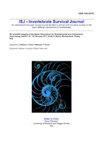无福尔马林实验室的冷水浴:海胆(Paracentrotus lividus)早期发育阶段的几种固定方法(Lamarck, 1816)
IF 1.2
4区 农林科学
Q4 IMMUNOLOGY
引用次数: 4
摘要
固定剂在生物和医学研究中广泛使用,因为它们可以长时间保存标本。从历史上看,甲醛是迄今为止使用最多的固定剂,但由于其致癌性,需要新的解决方案。在这项研究中,我们测试了几种不同的固定方法,以寻找一种无害、经济、简单的方法来固定样品,用于对lividus副尖腹鱼的幼虫形态分析。在两个单独的实验中,在受精后48 h,分别添加福尔马林Free Tissue AccustainTM、naoh缓冲的福尔马林Free Tissue AccustainTM、不同浓度(10%至70%)的冰川乙醇和变性乙醇,以及将含有幼虫的小瓶浸泡在0°C的海水中,并在4°C下保存144小时。我们的研究结果表明,从形态学角度来看,所有测试的替代固定剂都不能保证幼虫的良好质量,而面对热冲击并在4°C下保存的幼虫在整个时间内没有显示出任何损伤迹象。本研究结果表明,该方法可作为形态学和分类学识别研究中较好的、安全的福尔马林替代品,并为其在其他类型研究中的应用提供参考。本文章由计算机程序翻译,如有差异,请以英文原文为准。
A cold bath for a formalin-free laboratory: alternative fixative methods in early developmental stages of the sea urchin Paracentrotus lividus (Lamarck, 1816)
Fixatives are widespread in biological and medical research because they allow preserving specimens for a long time. Historically, formaldehyde has been the most used fixative so far, but new solutions are needed because of its carcinogenicity. In this study, we tested alternative fixative methods to find a harmless, economic, and simple-to-use methodology to fix samples for larval morphological analysis in Paracentrotus lividus. In two separate experiments, P. lividus embryos were fixed after 48 h post-fertilization by adding Formalin Free Tissue AccustainTM, NaOH-buffered Formalin Free Tissue AccustainTM, glacial ethanol and denatured ethanol at different concentrations (from 10 % to 70 %) and by submerging the vials containing the larvae in seawater at 0 °C and maintained at 4 °C for 144 h. Our results suggested that all the alternative fixatives tested do not guarantee a good quality of larvae for morphological purposes, while larvae that faced the thermal shock and were kept at 4 °C did not show any evidence of damage throughout time. The results of this study candidate this method as a good and safe substitute of formalin in studies that require morphological and taxonomic recognition and shed light on its use in other kinds of studies as well.
求助全文
通过发布文献求助,成功后即可免费获取论文全文。
去求助
来源期刊

ISJ-Invertebrate Survival Journal
IMMUNOLOGY-ZOOLOGY
CiteScore
2.10
自引率
0.00%
发文量
0
审稿时长
>12 weeks
期刊介绍:
Invertebrate Survival Journal (ISJ) is an international and open access journal devoted to prompt and innovative studies on the basic defense mechanisms in invertebrates, in particular with a view to identifying biotechnologies able to act against derived diseases and related economic damage.
Contributions will be mainly in the form of Letters to the Editor, Visions and Perspectives, Short Communications, Technical Reports, Research Reports, Review, Minireview and Reports of Meetings. Letters to the Editor can be commentaries or perspectives on invertebrate defence mechanisms or replies to the data published in ISJ.
 求助内容:
求助内容: 应助结果提醒方式:
应助结果提醒方式:


